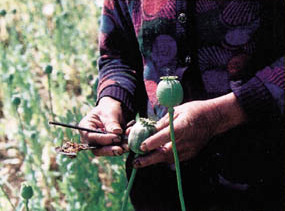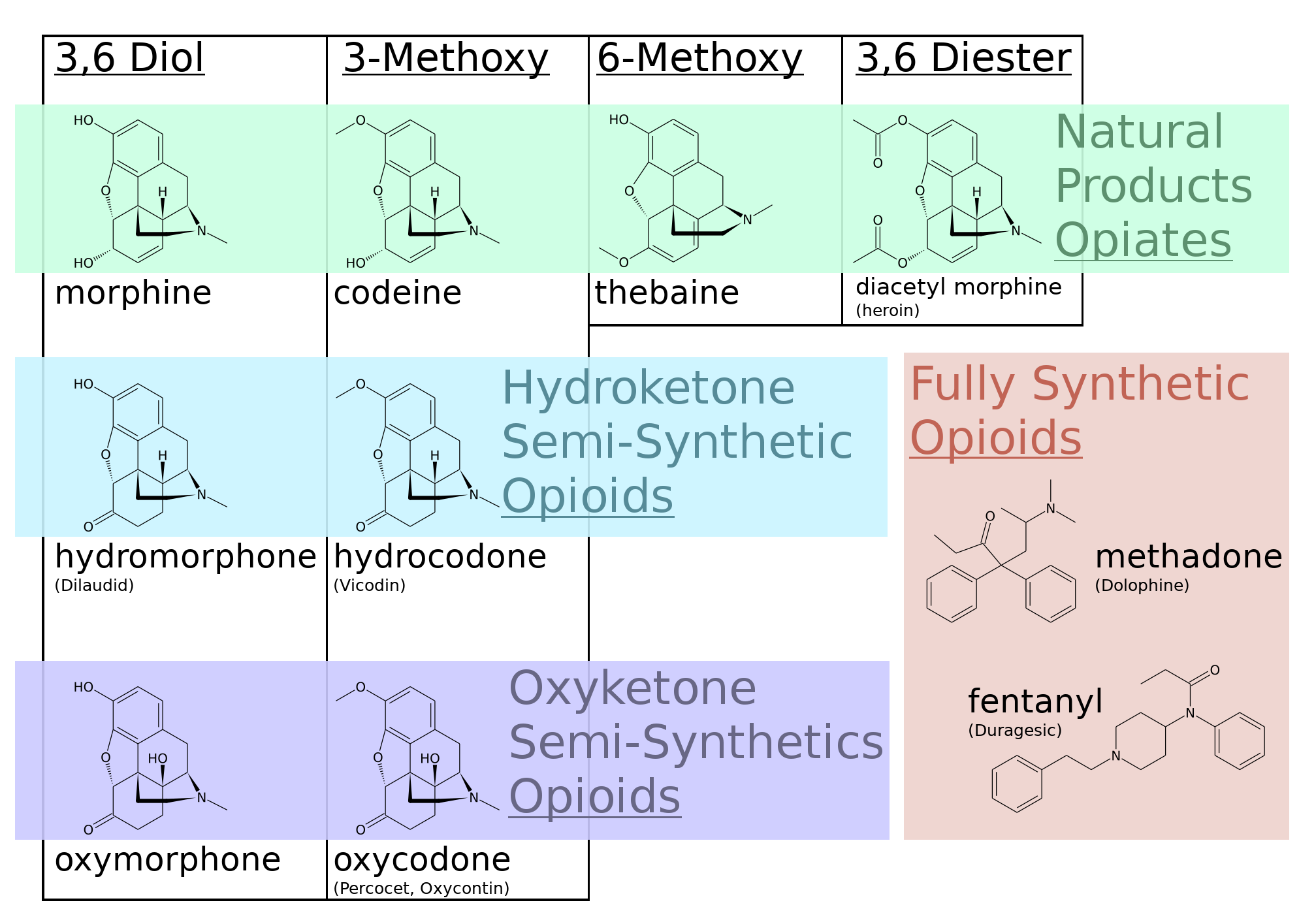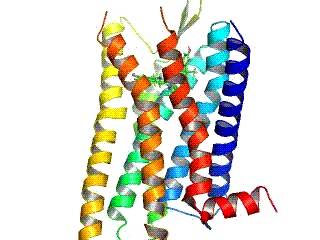|
Opiate
An opiate is an alkaloid substance derived from opium (or poppy straw). It differs from the similar term ''opioid'' in that the latter is used to designate all substances, both natural and synthetic, that bind to opioid receptors in the brain (including antagonists). Opiates are alkaloid compounds naturally found in the opium poppy plant ''Papaver somniferum''. The psychoactive compounds found in the opium plant include morphine, codeine, and thebaine. Opiates have long been used for a variety of medical conditions, with evidence of opiate trade and use for pain relief as early as the eighth century AD. Most opiates are considered drugs with moderate to high abuse potential and are listed on various "Substance-Control Schedules" under the Uniform Controlled Substances Act of the United States of America. In 2014, between 13 and 20 million people used opioids recreationally, representing 0.3% to 0.4% of the global population between the ages of 15 and 65. According to the CDC, ... [...More Info...] [...Related Items...] OR: [Wikipedia] [Google] [Baidu] |
Opioid
Opioids are a class of Drug, drugs that derive from, or mimic, natural substances found in the Papaver somniferum, opium poppy plant. Opioids work on opioid receptors in the brain and other organs to produce a variety of morphine-like effects, including analgesic, pain relief. The terms "opioid" and "opiate" are sometimes used interchangeably, but the term "opioid" is used to designate all substances, both natural and synthetic, that bind to opioid receptors in the brain. Opiates are alkaloid compounds naturally found in the opium poppy plant ''Papaver somniferum''. Medically they are primarily used for pain relief, including anesthesia. Other medical uses include suppression of diarrhea, replacement therapy for opioid use disorder, and Cold medicine, suppressing cough. The opioid receptor antagonist naloxone is used to reverse opioid overdose. Extremely potent opioids such as carfentanil are approved only for Veterinary medicine, veterinary use. Opioids are also frequently use ... [...More Info...] [...Related Items...] OR: [Wikipedia] [Google] [Baidu] |
Opium
Opium (also known as poppy tears, or Lachryma papaveris) is the dried latex obtained from the seed Capsule (fruit), capsules of the opium poppy ''Papaver somniferum''. Approximately 12 percent of opium is made up of the analgesic alkaloid morphine, which is processed chemically to produce heroin and other synthetic opioids for medicinal use and for the illegal drug trade. Opium's main psychoactive alkaloids, primarily morphine, act on μ-opioid receptors, causing analgesia and addiction with long-term use leading to tolerance, dependence, and increased cancer risk. The latex also contains the closely related opiates codeine and thebaine, and non-analgesic alkaloids such as papaverine and noscapine. The traditional, labor-intensive method of obtaining the latex is to scratch ("score") the immature seed pods (fruits) by hand; the latex leaks out and dries to a sticky yellowish residue that is later scraped off and dehydrated. The English word for opium is loan word, borrowed fro ... [...More Info...] [...Related Items...] OR: [Wikipedia] [Google] [Baidu] |
Opiates V Opioids
An opiate is an alkaloid substance derived from opium (or poppy straw). It differs from the similar term ''opioid'' in that the latter is used to designate all substances, both natural and synthetic, that bind to opioid receptors in the brain (including antagonists). Opiates are alkaloid compounds naturally found in the opium poppy plant ''Papaver somniferum''. The psychoactive compounds found in the opium plant include morphine, codeine, and thebaine. Opiates have long been used for a variety of medical conditions, with evidence of opiate trade and use for pain relief as early as the eighth century AD. Most opiates are considered drugs with moderate to high abuse potential and are listed on various "Substance-Control Schedules" under the Uniform Controlled Substances Act of the United States of America. In 2014, between 13 and 20 million people used opioids recreationally, representing 0.3% to 0.4% of the global population between the ages of 15 and 65. According to the CDC, ... [...More Info...] [...Related Items...] OR: [Wikipedia] [Google] [Baidu] |
Morphine
Morphine, formerly also called morphia, is an opiate that is found naturally in opium, a dark brown resin produced by drying the latex of opium poppies (''Papaver somniferum''). It is mainly used as an analgesic (pain medication). There are multiple methods used to administer morphine: oral; sublingual administration, sublingual; via inhalation; intramuscular, injection into a muscle, Subcutaneous injection, injection under the skin, or injection into the spinal cord area; transdermal; or via rectal administration, rectal suppository. It acts directly on the central nervous system (CNS) to induce analgesia and alter perception and emotional response to pain. Physical and psychological dependence and tolerance may develop with repeated administration. It can be taken for both acute pain and chronic pain and is frequently used for pain from myocardial infarction, kidney stones, and during Childbirth, labor. Its maximum effect is reached after about 20 minutes when administ ... [...More Info...] [...Related Items...] OR: [Wikipedia] [Google] [Baidu] |
Codeine
Codeine is an opiate and prodrug of morphine mainly used to treat pain, coughing, and diarrhea. It is also commonly used as a recreational drug. It is found naturally in the sap of the opium poppy, ''Papaver somniferum''. It is typically used to treat mild to moderate degrees of pain. Greater benefit may occur when combined with paracetamol (acetaminophen) or a nonsteroidal anti-inflammatory drug (NSAID) such as aspirin or ibuprofen. Evidence does not support its use for acute cough suppression in children. In Europe, it is not recommended as a cough medicine for those under 12 years of age. It is generally taken by mouth. It typically starts working after half an hour, with maximum effect at two hours. Its effects last for about four to six hours. Codeine exhibits abuse potential similar to other opioid medications, including a risk of addiction and overdose. Common side effects include nausea, vomiting, constipation, itchiness, lightheadedness, and drowsiness. Serious ... [...More Info...] [...Related Items...] OR: [Wikipedia] [Google] [Baidu] |
Codein - Codeine
Codeine is an opiate and prodrug of morphine mainly used to treat pain, coughing, and diarrhea. It is also commonly used as a recreational drug. It is found naturally in the sap of the opium poppy, ''Papaver somniferum''. It is typically used to treat mild to moderate degrees of pain. Greater benefit may occur when combined with paracetamol (acetaminophen) or a nonsteroidal anti-inflammatory drug (NSAID) such as aspirin or ibuprofen. Evidence does not support its use for acute cough suppression in children. In Europe, it is not recommended as a cough medicine for those under 12 years of age. It is generally taken by mouth. It typically starts working after half an hour, with maximum effect at two hours. Its effects last for about four to six hours. Codeine exhibits abuse potential similar to other opioid medications, including a risk of addiction and overdose. Common side effects include nausea, vomiting, constipation, itchiness, lightheadedness, and drowsiness. Serious sid ... [...More Info...] [...Related Items...] OR: [Wikipedia] [Google] [Baidu] |
Opioid Use Disorder
Opioid use disorder (OUD) is a substance use disorder characterized by cravings for opioids, continued use despite physical and/or psychological deterioration, increased tolerance with use, and withdrawal symptoms after discontinuing opioids. Opioid withdrawal symptoms include nausea, muscle aches, diarrhea, trouble sleeping, agitation, and a low mood. Addiction and dependence are important components of opioid use disorder. Risk factors include a history of opioid misuse, current opioid misuse, young age, socioeconomic status, race, untreated psychiatric disorders, and environments that promote misuse (social, family, professional, etc.). Complications may include opioid overdose, suicide, HIV/AIDS, hepatitis C, and problems meeting social or professional responsibilities. Diagnosis may be based on criteria by the American Psychiatric Association in the DSM-5. Opioids include substances such as heroin, morphine, fentanyl, codeine, dihydrocodeine, oxycodone, and hydrocodon ... [...More Info...] [...Related Items...] OR: [Wikipedia] [Google] [Baidu] |
Oxycodone
Oxycodone, sold under the brand name Roxicodone and OxyContin (which is the extended-release form) among others, is a semi-synthetic opioid used medically for the treatment of moderate to severe pain. It is highly addictive and is a commonly drug abuse, abused drug. It is usually taken oral administration, by mouth, and is available in immediate release, immediate-release and controlled release, controlled-release formulations. Onset of pain relief typically begins within fifteen minutes and lasts for up to six hours with the immediate-release formulation. In the United Kingdom, it is available by Injection (medicine), injection. Combination drug, Combination products are also available with oxycodone/paracetamol, paracetamol (acetaminophen), oxycodone/ibuprofen, ibuprofen, oxycodone/naloxone, naloxone, naltrexone, and oxycodone/aspirin, aspirin. Common side effects include euphoria, constipation, nausea, vomiting, Anorexia (symptom), loss of appetite, Somnolence, drowsiness, ... [...More Info...] [...Related Items...] OR: [Wikipedia] [Google] [Baidu] |
Poppy Straw
Poppy straw (also known as opium straw, mowed opium straw, crushed poppy capsule, poppy chaff, or poppy husk) is derived from opium poppies (''Papaver somniferum'') that are harvested when fully mature and dried by mechanical means. Opium poppy straw is what remains after the seed pods have been that is, the dried stalks, stem and leaves of poppies grown for their seeds. The field-dried leaves, stalk, and seed pod are then used in commercial manufacture of morphine or other poppy-alkaloid derived drugs, by first processing the material, separating the seeds, and then making concentrate of poppy straw where no extraction using the traditional methods of latex extraction has been made. The straw was originally considered an agricultural by-product of the mechanised poppy seed harvest, which was primarily grown for its edible and oil-producing seed. This changed in 1927 when János Kabay developed a chemical process to extract morphine from the crushed capsule. Concentrated poppy stra ... [...More Info...] [...Related Items...] OR: [Wikipedia] [Google] [Baidu] |
Opioid Receptors
Opioid receptors are a group of inhibitory G protein-coupled receptors with opioids as ligands. The endogenous opioids are dynorphins, enkephalins, endorphins, endomorphins and nociceptin. The opioid receptors are ~40% identical to somatostatin receptors (SSTRs). Opioid receptors are distributed widely in the brain, in the spinal cord, on peripheral neurons, and digestive tract. Discovery By the mid-1960s, it had become apparent from pharmacologic studies that opioids were likely to exert their actions at specific receptor sites, and that there were likely to be multiple such sites. Early studies had indicated that opiates appeared to accumulate in the brain. The receptors were first identified as specific molecules through the use of binding studies, in which opiates that had been labeled with radioisotopes were found to bind to brain membrane homogenates. The first such study was published in 1971, using 3H- levorphanol. In 1973, Candace Pert and Solomon H. Snyder pub ... [...More Info...] [...Related Items...] OR: [Wikipedia] [Google] [Baidu] |
Hydromorphone
Hydromorphone, also known as dihydromorphinone, and sold under the brand name Dilaudid among others, is a morphinan opioid used to treat moderate to severe pain. Typically, long-term use is only recommended for pain due to cancer. It may be used by mouth or by injection into a vein, muscle, or under the skin. Effects generally begin within half an hour and last for up to five hours. A 2016 Cochrane review (updated in 2021) found little difference in benefit between hydromorphone and other opioids for cancer pain. Common side effects include dizziness, sleepiness, nausea, itchiness, and constipation. Serious side effects may include abuse, low blood pressure, seizures, respiratory depression, and serotonin syndrome. Rapidly decreasing the dose may result in opioid withdrawal. Generally, use during pregnancy or breastfeeding is not recommended. Hydromorphone is believed to work by activating opioid receptors, mainly in the brain and spinal cord. Hydromorphone 2 ... [...More Info...] [...Related Items...] OR: [Wikipedia] [Google] [Baidu] |
Papaver Somniferum
''Papaver somniferum'', commonly known as the opium poppy or breadseed poppy, is a species of flowering plant in the family Papaveraceae. It is the species of plant from which both opium and poppy seeds are derived and is also a valuable ornamental plant grown in gardens. Its native range was the eastern Mediterranean region, but has since been obscured by widespread introduced species, introduction and Horticulture, cultivation since ancient times to the present day. It is now Naturalisation (biology), naturalized across much of the world with temperate climates. This poppy is grown as an agricultural crop on a large scale, for one of three primary purposes: to produce poppy seeds, to produce opium (for use mainly by the pharmaceutical industry), and to produce other alkaloids (mainly thebaine and oripavine) that are processed by pharmaceutical companies into drugs such as hydrocodone and oxycodone. Each of these goals has special breeds that are targeted at one of these busine ... [...More Info...] [...Related Items...] OR: [Wikipedia] [Google] [Baidu] |







